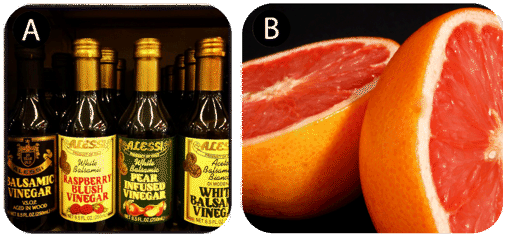7.5: Acid Nomenclature
- Page ID
- 366538
- Given the formula for a binary acid or oxyacid, write the systematic name.
- Given the systematic name for a binary acid or oxyacid, write the formula.
Acids
An acid can be defined in several ways. The most straightforward definition is that an acid is a molecular compound that contains one or more hydrogen atoms and produces hydronium ions \(\left( \ce{H3O^+} \right)\) when dissolved in water.

Acids are coalent compounds, which means that in their pure state they are individual molecules and do not adopt the extended three-dimensional structures of ionic compounds like \(\ce{NaCl}\). However, when these molecules are dissolved in water, the chemical bond between the hydrogen atom and the rest of the molecule breaks, creating a positively-charged hydronium ion and an anion. This can be symbolized in a chemical equation:
\[\ce{HCl} + \ce{H2O} \rightarrow \ce{H3O^+} + \ce{Cl^-}\]
The \(\ce{H}\) of an acid is written first in the formula of an inorganic acid. The remainder of the acid (other than the \(\ce{H}\)) is the anion after the acid dissolves.
Naming Acids
Since all acids contain hydrogen, the name of an acid is based on the anion that goes with it. These anions can either be monatomic or polyatomic. The name of the acid is based on the ending of the the anion it contains (either -ide, -ite, or -ate.)
Acids from -ide anions
Anions ending in -ide are largely monatomic. The predominant polyatomic exception is the cyanide ion. When an acid is formed from an -ide anion, the acid name begins with the prefix hydro- followed by the base name of the anion, followed by the suffix -ic.
The name follows this pattern: hydro- and base name of anion and -ic acid
What is the name of the acid with the formula HCl?
Solution
HCl contains the anion Cl-. Since Cl- is the chloride ion, the name of the acid will begin with hydro- and end with -ic acid. The base name of the anion is chloro. The name is therefore hydrochloric acid.
Acids from -ite anions
The name of the acids containing -ite anions is the root of the anion followed by the suffix -ous. There is no prefix.
The name follows this pattern: base name of anion and -ous acid
What is the name of the acid with the formula H2SO3?
Solution
H2SO3 contains the anion SO32- Since SO32- is the sulfite ion, the name of the acid will end with -ous acid. The base name of the anion is sulfur. The name is therefore sulfurous acid.
Acids from -ate anions
The name of the acid is the root of the anion followed by the suffix -ic. There is no prefix.
The name follows this pattern: base name of anion and -ic acid
What is the name of the acid with the formula H3PO4?
Solution
H3PO4 contains the anion PO43- Since PO43- is the phosphate ion, the name of the acid will end with -ic acid. The base name of the anion is phosphor. The name is therefore phosphoric acid.
The base name for sulfur containing oxyacid is sulfur- instead of just sulf-. The same is true for a phosphorus containing oxyacid. The base name is phosphor- instead of simply phosph-.
Writing Formulas for Acids
Like other compounds that we have studied, acids are electrically neutral. Therefore, the charge of the anion part of the formula must be exactly balanced out by the \(\ce{H^+}\) ions. Another way to think about writing the correct formula is to utilize the crisscross method, shown below for sulfuric acid.
Formula: H2SO4
Figure \(\PageIndex{2}\): Crisscross approach to writing formula for sulfuric acid.
Write the formula and the name of the acid formed from each of the following anions.
- S2-
- NO3-
- PO33-
Solution
- Two hydrogen ions are needed to neutralize the -2 charge of the sulfide ion. The formula is therefore H2S. Since the anion ends in -ide, the name of the acid is hydrosulfuric acid.
- One hydrogen ion is needed to neutralize the -1 charge of the nitrate ion. The formula is therefore HNO3. Since the name of the anion ends in -ate, the name of the acid is nitric acid.
- Three hydrogen ions are needed to neutralize the -3 charge of the phosphite ion. The formula is therefore H3PO3. Since the name of the anion ends in -ite, the name of the acid is phosphorous acid
Write the formula and the name of the acid formed from each of the following anions.
- SO42-
- NO2-
- F-
- Answer a:
- H2SO4 sulfuric acid
- Answer b:
- HNO2 nitrous acid
- Answer c:
- HF hydrofluoric acid
Contributions & Attributions
This page was constructed from content via the following contributor(s) and edited (topically or extensively) by the LibreTexts development team to meet platform style, presentation, and quality:
Henry Agnew (UC Davis)

